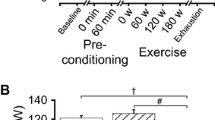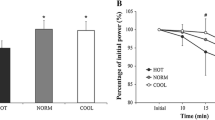Abstract
The aim of this study was to assess whether the three-compartment model of mean body temperature (Tb3) calculated from the esophageal temperature (Tes), temperature in deep tissue of exercising muscle (Tdt), and mean skin temperature (Tsk) has the potential to provide a better match with the thermoregulatory responses than the two-component model of mean body temperature (Tb2) calculated from Tes and Tsk. Seven male subjects performed 40 min of a prolonged cycling exercise at 30% maximal oxygen uptake at 21°C or 31°C (50% relative humidity). Throughout the experiment, Tsk, Tb2, Tb3, and Tdt were significantly (P < 0.01) lower at 21°C than at 31°C temperature conditions, while Tes was similar under both conditions. During exercise, an increase in cutaneous vascular conductance (skin blood flow / mean arterial pressure) over the chest (%CVCc) was observed at both 21°C and 31°C, while no increase was observed at the forearm at 21°C. Furthermore, the Tb3 and Tdt threshold for the onset of the increase in %CVCc was similar, but the Tes and Tb2 threshold differed significantly (P < 0.05) between the conditions tested. These results suggest that active cutaneous vasodilation at the chest is related more closely to Tb3 or Tdt than that measured by Tes or Tb2 calculated by Tes and Tsk during exercise at both 21°C and 31°C.





Similar content being viewed by others
References
Alvarez GE, Kun Z, Wojciech A, Johnson MJ (2006) Relative roles of local and compartments in cutaneous vasoconstriction during skin cooling in humans. J Appl Physiol 100:2083–2088
Amann M, Blain GM, Proctor LT, Sebranek JJ, Pegelow DF, Dempsey JA (2010) Group III and IV muscle afferents contributes to ventilatory and cardiovascular response to rhythmic exercise in humans. J Appl Physiol 109:966–976
Booth J, Wilsmore BR, Macdonald AD, Zeyl A, Mcghee S, Calvert D, Marino FE, Strorlien LH, Taylor NAS (2001) Whole body pre-cooling does not alter human muscle metabolism during sub-maximal exercise in the heat. Eur J Appl Physiol 84:587–590
Brajkovic D, Ducharme MB (2005) Confounding factors in the use of the zero-heat-flow method for non-invasive muscle temperature measurement. Eur J Appl Physiol 94:386–391
Charkoudian N, Johnson JM (1999) Reflex control of cutaneous vasoconstrictor system is reset by exogenous female reproductive hormones. J Appl Physiol 87:381–385
Fox RH, Solman AJ, Isaacs R, Fry AJ, MacDonald IC (1973) A new method for monitoring deep body temperature from the skin surface. Clin Sci 44:81–86
Gagge AP, Nishi Y (1977) Heat exchange between human skin surface and thermal environment. In: Lee DHK (ed) Handbook of physiology. American Physiological Society, Bethesda
Hayashi K, Honda Y, Ogawa T, Kondo N, Nishiyasu T (2006) Relationship between ventilatory response and body temperature during prolonged sub-maximal exercise. J Appl Physiol 100:414–420
Hayashi K, Honda Y, Ogawa T, Kondo N, Nishiyasu T (2009) The cross-sectional relationship among hyperthermia-induced hyperventilation, peak oxygen consumption, and the sutaneous vasodilatory response during exercise. Eur J Appl Physiol 107:527–534
Hertel H, Howaldt B, Mense S (1976) Responses of group IV and group III muscle afferents to thermal stimuli. Brain Res 113:201–205
Jay O, Garièpy LM, Reardon FD, Webb P, Ducharme MB, Ramsay T, Kenny GP (2007) A three-compartment thermometry model for the improved estimation of changes in body heat content. Am J Physiol Regul Integr Comp Physiol 292:R167–R175
Jessen C, Feistkorn G, Nagel A (1983) Temperature sensitivity of skeletal muscle in the conscious goat. J Appl Physiol 54:880–886
Kacin A, Golja P, Eiken O, Tipton MJ, Gorjanc J, Mekjavic IB (2005) Human temperature regulation during cycling with moderate leg ischaemia. Eur J Appl Physiol 95:213–220
Kenny GP, Reardon FD, Zaleski W, Reardon ML, Haman F, Ducharme MB (2003) Muscle temperature transients before, during, and after exercise measured using an intramuscular multisensor probe. J Appl Physiol 94:2350–2357
Kondo N, Nishiyasu T, Inoue Y, Koga S (2010) Non-thermal modification of heat-loss responses during exercise in humans. Eur J Appl Physiol 110:447–458
Kuwahara T, Inoue Y, Taniguchi M, Ogura Y, Ueda H, Kondo N (2005) Effects of physical training on heat loss presponses of young women to passive heating in relation to menstrual cycle. Eur J Appl Physiol 94:376–385
Matsukawa T, Kashimoto S, Ozaki M, Shindo S, Kumazawa T (1996) Temperatures measured by adeep body thermometer (Coretemp) compared with tissue temperatures measured at various depths using needles placed into the sole of the foot. Eur J Anaesthesiol 13:340–345
Mekjavic IB, Eiken O (2006) Contribution of thermal and nonthermal factors to the regulation of body temperature in humans. J Appl Physiol 100:2065–2072
Mekjavic IB, Rempel ME (1990) Determination of esophageal probe insertion length based on standing and sitting height. J Appl Physiol 69:376–379
Muravchick S (1983) Deep body thermometry during general anesthesia. Anethesiology 58:271–275
Nadel ER, Mitchell JW, Stolwijk AJ (1979) Differential thermal sensitivity in the human skin. Pfügers Arch 340:1084–1089
Nagamine S, Suzuki S (1964) Anthropometry and body composition of Japanese young men and women. Hum Biol 36:8–15
Nishiyasu T, Shi X, Gillen CM, Mack GW, Nadel ER (1992) Comparison of the forearm and calf blood flow response to thermal stress furing dynamic exercise. Med Sci Sports Exerc 24:213–217
Oksa J, Rintamäki H, Rissanen S (1997) Muscle performance and electromyogram activity of the lower leg muscle with different levels of cold exposure. Eur J Appl Physiol 75:484–490
Pérgola PE, Johnson JM, Kellogg DL, Kosiba WA (1996) Control of skin blood flow by whole body and local skin cooling in exercising humans. Am J Physiol 270:H208–H215
Ritzema HP (1994) Frequency and regression analysis (chapter 6). Drainage principles and applications 16, ILRI, Wageningen, Netherlands, pp 175–224
Robinson S, Meyer FR, Newton JL, Ts’ao CH, Holgersen LO (1965) Relations between sweating, cutaneous blood flow, and body temperature in work. J Appl Physiol 20:575–582
Sargeant AJ (1987) Effect of muscle temperature on leg extension force and short-term power output in humans. Eur J Appl Physiol 56:693–698
Shin-ya H, Nakai S, Yoshida T, Takahashi E (2005) Effects of sportswear on thermoregulatory responses during exercise in a hot environment. In: Tochihara Y, Ohnaka T (eds) Environmental ergonomics, Elsevier ergonomics book series vol. 3. Elsevier, UK, pp 65–70
Stephens DP, Aoki K, Kosiba WA, Johnson JM (2001) Nonnoradrenergic mechanism of reflex cutaneous vasoconstriction in men. Am J Physiol Heart Circ Physiol 280:H1496–H1504
Stewart D, Macaluso A, De Vito G (2003) The effect of an active warm-up on surface EMG and muscle performance in healthy humans. Eur J Appl Physiol 89:509–513
Stolwijk JA, Hardy JD (1966) Temperature regulation in man—a theoretical study. Pfügers Arch 291:129–162
Togwa T, Nemoto T, Yamazaki T, Kobayashi T (1976) A modified internal temperature measurement device. Med Biol Eng 14:361–364
Werner J (1980) The concept of regulation for human body temperature. J Therm Biol 5:75–82
White MD (2006) Components and mechanisms of thermal hyperpnea. J Appl Physiol 101:655–663
Yamakage M, Namiki A (2003) Deep temperature monitoring using a zero-heat-flow method. J Anesth17:108–115
Yamakage M, Iwasaki S, Namiki A (2002) Evaluation of a newly developed monitor of deep body temperature. J Anesth 16:354–357
Yamazaki F (2002) Vasomotor responses in glabrous and nonglabrous skin during sinusoidal exercise. Med Sci Sports Exerc 34:767–772
Author information
Authors and Affiliations
Corresponding author
Rights and permissions
About this article
Cite this article
Demachi, K., Yoshida, T. & Tsuneoka, H. Relationship between mean body temperature calculated by two- or three-compartment models and active cutaneous vasodilation in humans: a comparison between cool and warm environments during leg exercise. Int J Biometeorol 56, 277–285 (2012). https://doi.org/10.1007/s00484-011-0430-9
Received:
Revised:
Accepted:
Published:
Issue Date:
DOI: https://doi.org/10.1007/s00484-011-0430-9




